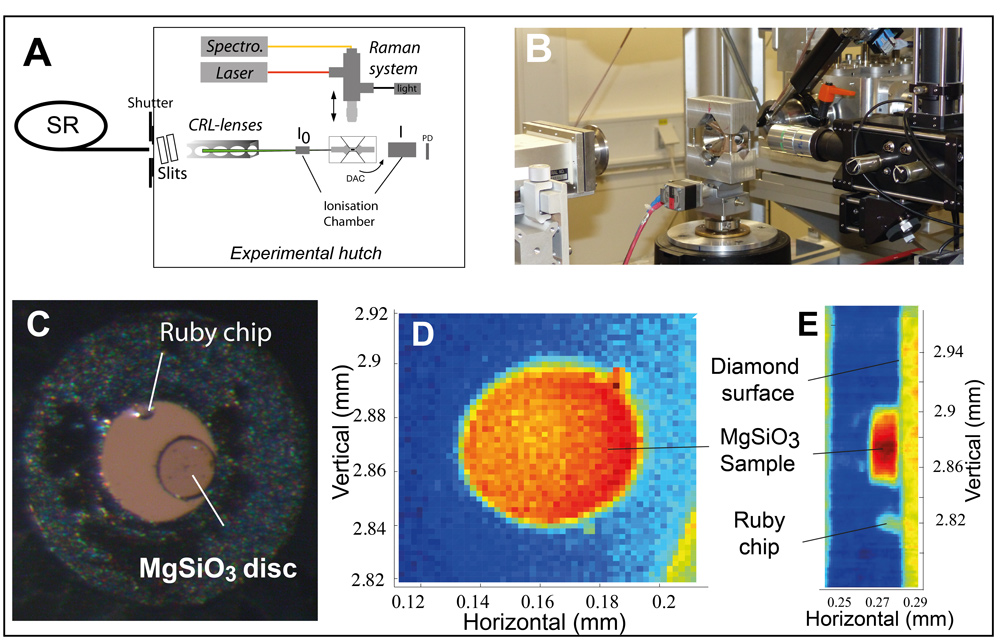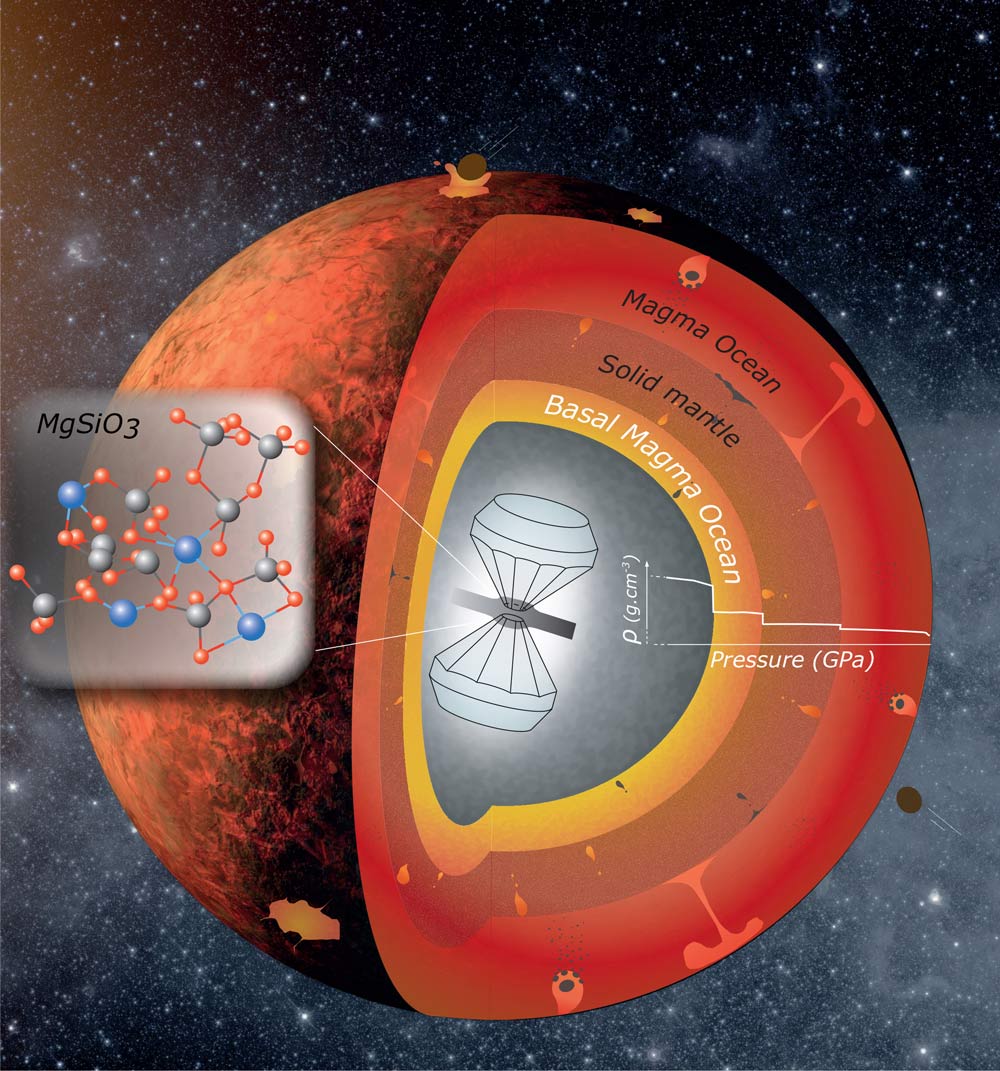- Home
- News
- General News
- Remnants of an ancient...
Remnants of an ancient magma ocean in the deep Earth revealed
02-11-2015
Scientists have revealed that silicate magmas, mainly composed of MgSiO3 are denser than the rocks of the lowermost mantle. This means that the silicate melts would accumulate in the deep Earth at the core-mantle boundary and that during the Earth's formation a giant magma ocean could have formed at the base of the mantle.
An international team of scientists led by Sylvain Petitgirard, from the University of Bayreuth (Germany), in collaboration with the ESRF, the European Synchrotron, Grenoble, France, revealed that silicate magmas, mainly composed of MgSiO3, are denser than the rocks of the lowermost mantle. This means that the silicate melts would accumulate in the deep Earth at the core–mantle boundary. During the Earth's formation, a huge production of magmas could then have enabled the formation of a giant magma ocean at the base of the mantle. Today, seismic observations of the deep Earth highlight dense areas at the base of the mantle that could be the remnants of this ancient basal magma ocean that dates the Earth's formation.
For these challenging density measurements, the scientists developed new techniques in collaboration with the ESRF's ID13 beamline, using the X-ray absorption method. They were able to measure the density of amorphous MgSiO3 up to extreme conditions of pressure, never before reached for this type of measurement. The experiment reproduced the pressure conditions found in the deepest part of the lower mantle at a depth of 2900 km, namely 1.35 million atmospheres. This fundamental result published in the Proceedings of the National Academy of Sciences (PNAS) has important implications for understanding the composition, dynamic, and evolution of the Earth's interior through time, and moreover can explain how material as old as the Earth could remain intact in the deepest part of the mantle for 4.5 billion years.
|
|
|
Schematic view of the Earth's interior after the moon-forming giant impact, ~ 4.5 billion years ago. The solid mantle crystallises at an intermediate depth and a dense magma ocean forms at the top of the core. Credits: @sylvain Petitgirard/ Bayreuth University. |
Variations in seismic velocities observed in the deep mantle could be attributed to melting phenomena, or even a deep hidden geochemical reservoir that dates from the early differentiation of the Earth. One key for understanding the stratification and origin of these seismic variations in the deep mantle lies in the determination of the density contrast between solid and liquid silicate phases. However, the density of silicate melts, mainly composed of MgSiO3 (90%), at extreme conditions down to 2900 km depth is poorly known while it is of fundamental importance constraining the composition, dynamic and evolution of the Earth’s interior through time.
Four and a half billion years ago, planetary bodies, some the size of Mars, impacted the Earth releasing a tremendous amount of energy that enabled large-scale melting. It has long been thought that the mantle would crystallize from the bottom to the top after such a giant melting event, with crystals being denser than melts and buoyant melts rising to the surface. However, this vision has been challenged over the past decade by recent calculations still unconfirmed by experiments.
Measuring the density of MgSiO3 melts is extremely challenging
As explained by Sylvain Petitgirard, main author of the study "our vision of the Earth interior formation has changed over the last decade because of new calculations that predict the possible accumulation of dense magmas on top of the core, but these models have not been confirmed experimentally. Studying melts at pressures equivalent to those found at 2900 km depth in the Earth is very challenging but extremely important for understanding the past and present evolution of the Earth's mantle. We developed a new technique, which combined the high resolution and brillance of the X-ray beam at the ESRF. This new technique allowed us to measure the density of MgSiO3 at the conditions of the lower mantle and confirmed the conclusions of recent models."
Unlike the crystalline MgSiO3 bridgmanite (the most abundant mineral in the deep Earth), MgSiO3 melts are not composed of atoms ordered in a long-range periodic arrangement. This means that traditional diffraction techniques will produce a weak diffuse signal. To overcome this issue, the scientific team adapted the X-ray absorption method to the small dimensions of the diamond anvil cell, enabling density measurements of the amorphous MgSiO3 in unprecedented conditions of pressure.
They placed a piece of MgSiO3 glass (the equivalent of melt at room temperature), with a very small diameter and with similar thickness to a strand of hair, in between two diamonds and squeezed it to pressures of the deep Earth. Using the micrometer beam at the ESRF's ID13 beamline, they could measure the attenuation of the X-ray beam through the sample and its dimensions, allowing the calculation of the MgSiO3 glass density at high pressure.
 |
|
Experimental details and description. A-B Schematic view and picture of the experimental set-up on the ID13 beamline. C-Picture of the sample (MgSiO3 disc), immersed in a liquid and squeezed in between two diamonds. D-E Images of the sample made with the micro X-ray beam: D gives the dimension of the sample and E the X-ray attenuation, the density is obtained by combining both maps. Credits: @sylvain Petitgirard/ Bayreuth University |
Thanks to this technique, they discovered that MgSiO3 glass and MgSiO3 bridgmanite crystals have the same density at very high pressure*. Taking into account the affinity of iron for silicate liquid, the study concluded that silicate magmas, mainly composed of MgSiO3, are denser than the rocks of the lowermost mantle and that melts could accumulate above the core-mantle boundary. During the Earth's formation, a huge production of magmas could have enabled the formation of a giant magma ocean at the base of the mantle. Today, seismic observations of the deep Earth highlight dense areas at the base of the mantle that could be the remnants of this ancient basal magma ocean that dates the Earth's formation, 4.5 billion years ago.
Manfred Burghammer, scientist on the ESRF's ID13 beamline where the experiments were conducted, said: “Coming originally from a scientific background related to geosciences, I am very pleased to see how synchrotron micro-beam experiments can help to elucidate fundamental questions about the composition of our planet. I think that this method bears a high potential regarding similar scientific questions in this field."
* at the core–mantle boundary pressure, the density of MgSiO3 glass is 5.48 ± 0.18 g/cm3, which is only 1.6% lower than that of MgSiO3 bridgmanite at 5.57 g/cm3.
Reference
Fate of MgSiO3 melts at core-mantle boundary conditions. Sylvain Petitgirard, Wim J. Malfait, Ryosuke Sinmyo, Ilya Kupenko, Louis Hennet, Dennis Harries, Thomad Dane, Manfred Burghammer, and Dave C. Rubie - "PNAS", 2 November 2015
http://www.pnas.org/content/early/2015/10/30/1512386112.abstract
Top image: Schematic view of the Earth's interior after the moon-forming giant impact ~4.5 billion years ago. Credit: Sylvain Petitgirard/Bayreuth University.




